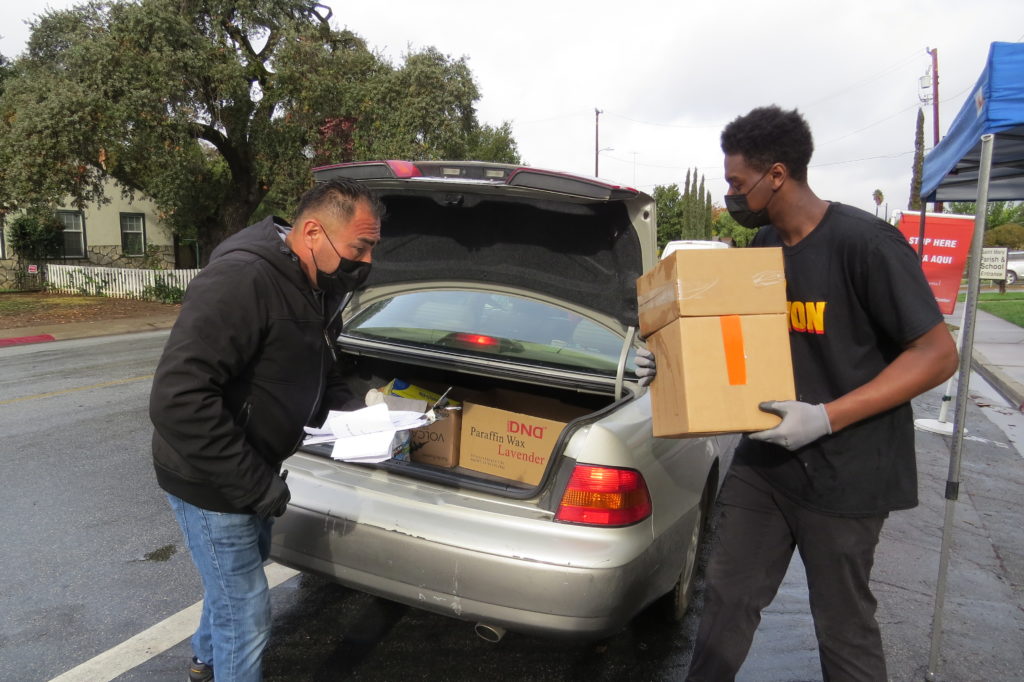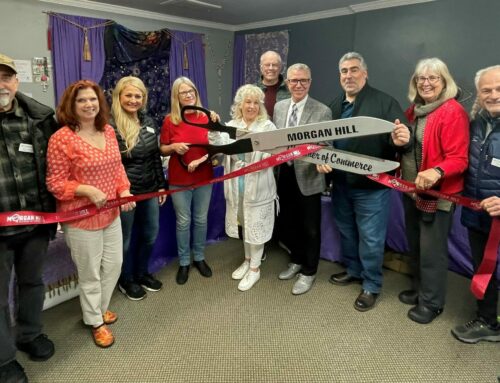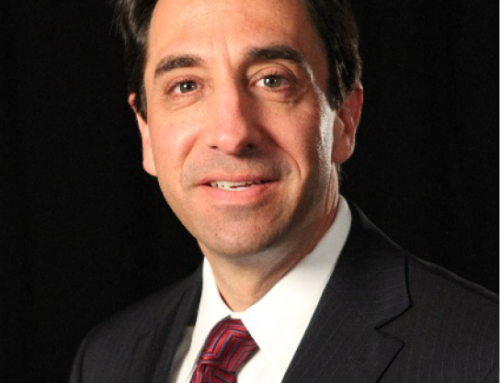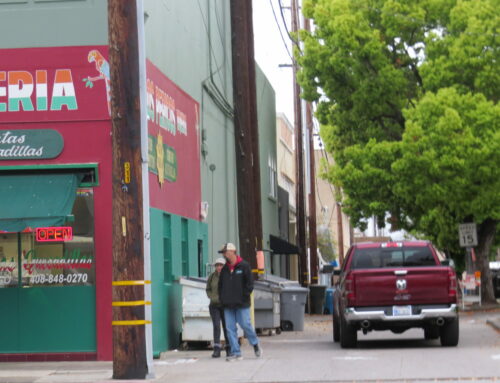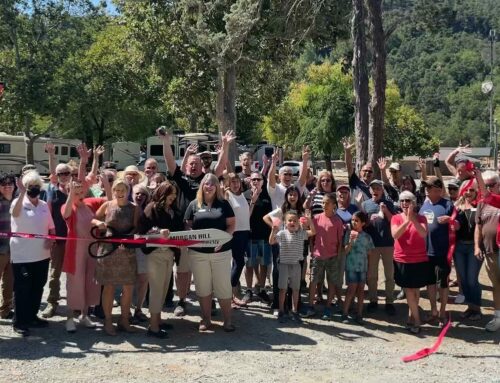South Valley nonprofits distribute food to help alleviate daily struggle
Photo by Marty Cheek
St. Joseph’s staff Paul Olvera (left) and Jovonte Jones (right) load a car’s trunk with boxes of food.
By Marty Cheek
On a cold morning recently, a bumper-to-bumper line of about 60 cars, trucks and SUVs hugged the curb on Church and First streets in Gilroy, the drivers edging along at a slow pace. One by one, as each vehicle reached the front of the line, the crew at St. Joseph’s Family Center scrambled to quickly place into the trunks or backseats boxes and bags containing food for families and individuals.
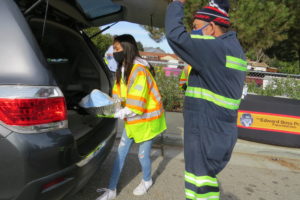
Photos by Marty Cheek
Above: Live Oak High School Interact club member Monica Iboa loads a frozen turkey into a car with assistance from Cecelia’s Closet’s Gary Ponzini. Right: Interact member Saige Hubbard prepares a turkey.
Carrying the groceries to the waiting vehicles, Jovonte Jones is an 18-year-old student at Gavilan Community College who graduated in spring from Oak Grove High School in San Jose. Seeing the seemingly never-ending stream of cars, trucks and SUVs lined up for their pick-up allows the young man to understand the severity of the pandemic’s impact on the South Valley’s community members — some from Morgan Hill and San Martin — and feel compassion for those in need.
“My mom works for the county and helps all these homeless people and she knew I needed a job,” he said. “She asked (the St. Joseph’s executive director) if I could work here during the summer. It was my first job and it involved a lot of lifting and stuff. But then when I saw the need of people for food and stuff, I felt glad to help them. I feel like I’m making a change in the world.”
With the recent surging of confirmed cases of people with COVID-19, American food banks have seen a parallel rise in the number of people who require nutritional assistance. Vicky Martin, a coordinator at St. Joseph’s, described how the rising coronavirus numbers required the nonprofit to increase its staff by a couple of members to support the distribution process.
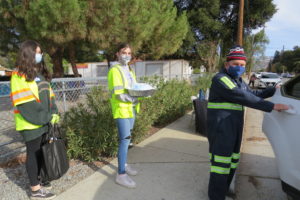
Rotary Interact service club member Saige Hubbard carries a turkey to a car as Gary Ponzini with Cecelia’s Close opens the back door.
Photo by Marty Cheek
“We went from serving 80 to 100 families a day in our pantry, to in the peak in May and June when we went up to 900 a day,” she said. “Then we’ve kind of leveled off at 500. Now we’re seeing it rising to about 600 a day as the curve goes back up.”
Many of the people are new clients, families who prior to the pandemic never dreamed they would be facing the challenge of food insecurity. The crisis has exacerbated the problem because shelter-in-place orders by county and state officials forced many people to deal with employment challenges.
“Gilroy is very service oriented so if the businesses close, the restaurants and the stores, our community gets hit hard,” Martin said.
The challenge is a national one that is growing more complicated as COVID-19 confirmed cases rapidly increase. Before the start of the pandemic in March, about 35 million Americans — including nearly 11 million children — lived in homes where the food supply was insecure, according to Feeding America, a leading national nonprofit food bank network. That was the lowest food insecurity rate the nation had seen in 20 years.
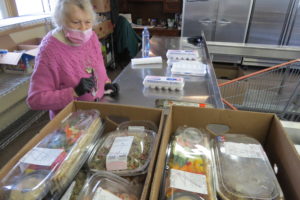
Photo by Marty Cheek
St. Joseph’s volunteer Theresé Olker sorts through donated food items to make sure they are safe to give to those in need.
If the unemployment rate averages 10.5 percent this year and the poverty rate comes in above 14 percent, which Feeding America projects the U.S. to hit, more than 50 million Americans will experience food insecurity, including about 17 million children.
About four in 10 Americans report they experienced food insecurity for the first time during the COVID-19 pandemic. This is the finding of a poll of 2,000 adults released in mid-November conducted by market research company OnePoll. About half of the men and women surveyed say they’ve struggled to afford groceries, while 37 percent describe skipping meals themselves so there was enough food for their children to eat.
There are people who want to help those in need. For the past several months, Theresé Olker has worked at St. Joseph’s sorting through food that comes from supermarkets and retail stores. The 82-year-old woman drives from her home in Santa Cruz twice a week to volunteer at the food pantry. On one morning, she went through egg cartons selecting fresh eggs that had not been broken and placing them in new cartons to be later distributed to needy individuals and families.
“Instead of sitting home, this is helping people,” she said. “I’d rather be helping my community instead of sitting around and watching TV . . . We make sure that everything is OK before we hand the food out.”
Many South Valley residents who had jobs before the pandemic now find themselves laid off or with reduced hours. That means hard-working people who are doing everything right will need extra help feeding themselves and their families. And that’s where food distribution sites such as St. Joseph’s and Cecelia’s Closet and Reach Out in Morgan Hill step in to fill the gap during the coronavirus crisis.
 This historic moment of a global pandemic might also provide an opportunity for the individuals of the South Valley to step back and ponder the importance of taking the time to help their fellow human beings who face hardships and loss, said David Cox, executive director at St. Joseph’s.
This historic moment of a global pandemic might also provide an opportunity for the individuals of the South Valley to step back and ponder the importance of taking the time to help their fellow human beings who face hardships and loss, said David Cox, executive director at St. Joseph’s.
“I think that for the first time people are starting to realize that something like this is not brought upon by people being lazy or addicted to drugs or making bad choices. This is a global thing and I think it’s really opening people’s eyes,” he said. “I’m really hoping that this is something we can learn from and maybe develop a little empathy and compassion.”
Every year during the holidays, food distribution centers see an overwhelming spirit by residents who volunteer time and donate money and food. But then when January hits, the generosity plummets as people get back into the regular swing of their lives.
 “How do we keep that spirit alive?” Cox wondered. “I think the good that can come out of this pandemic is the realization we’re all in this together. We have to look at it that way.”
“How do we keep that spirit alive?” Cox wondered. “I think the good that can come out of this pandemic is the realization we’re all in this together. We have to look at it that way.”
Paul Olvera manages the distribution of the boxes of food to the clients at the St. Joseph site. He’s worked with the nonprofit for eight and a half years and has seen the sharp rise of people in need.
“The numbers went up at the beginning, went down a bit, and now they’re spiking again.
He understands people felt confined and constricted in their activities during the shelter-in-place. After months of the restrictions, coronavirus fatigue led to complacency among many. But the restrictions are necessary to stop the spreading of the disease, he said.
“I’m OK with the shut down because I believe in safety first,” he said. “I know the shut-down is going to cause our numbers (of people in need) to spike right up, but I’m for it so long as the cases go down. I don’t mind serving a thousand people in a day so long as we keep the cases down.”


